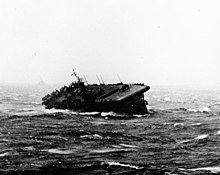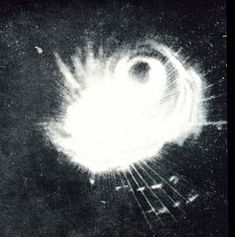Typhoon Cobra
| Radar image of the typhoon on December 18, 1944 | ||
| Emergence | December 17, 1944 | |
| resolution | December 18, 1944 | |
|
Peak wind speed |
|
|
| Lowest air pressure | ≤ 907 hPa ( mbar ) | |
| dead | 790 US soldiers, others unknown | |
| Property damage | Unknown | |
|
Affected areas |
Philippine Sea | |
| Season overview: Pacific typhoon seasons 1940–1944 |
||
The Typhoon Cobra was a tropical cyclone that on December 18, during the 1944 World War II , the Task Force 38 of the US Pacific fleet under Admiral Halsey of the Philippines hard hit about 200 nautical miles east. Three destroyers overturned as a result of the storm and several ships were damaged, some severely. A total of 790 seafarers were killed and 80 injured. These heavy losses led to the establishment of the United States Navy and Air Force joint meteorological department, now operating as the Joint Typhoon Warning Center .
initial situation
After the American landing on Mindoro on December 15, Admiral Halsey moved after three days of heavy air raids and Küstenbeschießungen on positions of the Japanese army on Mindoro and Luzon , the Task Force 38 for refueling of the ships back. The fuel transfer was to take place out of the range of Japanese aircraft in the Philippine Sea about 200 nautical miles off the coast of Luzon. The TF 38 consisted of seven aircraft carriers of Essex class , six light carriers , eight battleships , including the USS New Jersey , Halsey's flagship, four heavy and eleven light cruisers and 50 destroyers. Most of the ships in Halsey's formation, especially the destroyers, which had accompanied the fast carriers for three days at top speed, had little fuel left and some of the tanks were only 15% full. The required fuel was to be supplied by a formation of twelve fleet tankers from the 3rd US Fleet, which were accompanied by three tugs, five destroyers and ten escort destroyers as well as five escort aircraft carriers with reserve aircraft under the command of Captain Jasper T. Acuff.
Formation of the storm
The first reports of the approaching storm reached the United States Navy Weather Service on December 14th, when a pilot reported a "tropical disturbance" about 60 nautical miles southeast of Samar . Due to the rapid advance of the Americans in the Pacific, the expansion of the weather station network had fallen behind, so that the storm could no longer be followed in the following days. Commander GF Kosco, the responsible meteorological officer on board the flagship New Jersey , suspected the storm about 450 nautical miles east of the formation in the early afternoon of December 17.
December 17th

On the morning of December 17, Halsey's TaskForce met the tankers and immediately began collecting fuel. Despite wind force 8 and very choppy seas, some ships were able to successfully take over fuel, for example about 26 tons of fuel were pumped from the tanker USS Manatee to the USS Maddox in three hours . The attempts of the New Jersey to refuel the destroyers USS Spence and USS Hunt failed because the fuel hoses tore and the ships threatened to collide in the rough seas. Attempts to fly the reserve aircraft onto the fleet carriers were also given up around noon, as the aircraft could no longer land on the carriers pounding in the heavy seas. Two pilots who were still in the air with their F6F Hellcat around 3 p.m. were ordered to abandon the aircraft and parachute out.
At 12.51 p.m. Admiral Halsey broke off the refueling attempts and ordered the formation to the second meeting point further northwest, where the refueling of the remaining ships was to be completed the next morning. With this he brought the ship's formation exactly into the course of the storm, which was not, as the meteorological officer suspected, 450 nautical miles away, but only 120 nautical miles to the southeast and gained strength and speed.
During the night the ship's formation maintained its northwest course, there was no indication that it was steering directly into the cyclone, as neither the wind increased nor the barometer fell noticeably. The meeting point for the refueling maneuver the next morning was moved two more times in the hope of finding calmer seas, but then led the association on a north course exactly into the typhoon.
December 18th

In the early morning hours of December 18th, the signs of the approaching storm increased, the barometer fell and the wind rose to 30 knots . Halsey had his meteorologists make a new forecast about the storm, but it was wrong by about 90 nautical miles. The report prompted him to turn around in order to steer the ships into a supposedly calmer area of the storm. The formation steamed south at 15 knots. At 7 a.m. another attempt was made to refuel some ships, but the strong winds of 34 knots and the heavy swell made this impossible. This continued until about 10 am, as Halsey was desperate to provide air support for the troops on Mindoro. The storm got stronger and stronger, around 10 o'clock the wind speed was up to 43 knots when the barometer began to fall rapidly.
The Spence , which had tried to take over fuel from the New Jersey at around 8 a.m. , began to roll and roll heavily because the ballast tanks were not flooded and the ship was lying high in the water. At around 11 a.m. she rolled hard to port, the electrical system failed and the rudder blocked. After another heavy roll movement, the Spence capsized shortly after 11 a.m. and sank with 317 crew members on board. 23 sailors and one officer were rescued from nearby ships.
Half an hour later, the destroyer USS Monaghan , even closer to the center of the storm, was taking in water through the funnels when the ship was also rolling heavily. As a result, the engine failed and the ship lay in the meter-high waves without drive or steering. Shortly before noon she capsized to starboard, almost the entire crew went down with the ship, only six men could be rescued.
The destroyer USS Hull capsized at around 11 a.m. in heavy winds, some of which were 110 knots, and sank with 202 of the 264 men on board.
Around noon the storm gained more force, the average wind speed was over 70 knots, gusts of up to 120 knots were measured. The barometer fell to 907 mbar.
Shortly after 9 a.m., a fire broke out on the light aircraft carrier USS Monterey after leaking jet fuel from damaged aircraft ignited. The burning planes were thrown overboard in daring actions. The same happened shortly before 11 a.m. on the carrier USS Cowpens and shortly after 12 p.m. on the escort carrier USS Cape Esperance . However, the fire could be extinguished by the porters' deck crews.
consequences
As the typhoon subsided in the afternoon and the weather improved, the damage it had caused became apparent. Three destroyers had sunk, the other ships were partly badly damaged, almost all radar and radio antennas as well as everything on deck had been swept away by the storm. Several aircraft went overboard on the aircraft carriers, and the reconnaissance aircraft of many cruisers and battleships were torn away. A total of 122 aircraft were lost and 24 more so badly damaged that they had to be scrapped. 790 sailors died in the storm, most of them with the sunken destroyers, but also on other ships. 80 crew members were injured, some seriously. Nine ships, including a cruiser and three light carriers, were so badly damaged that they had to go to the dock for lengthy repairs. 19 other ships were slightly damaged.
In the next three days, 92 survivors were fished out of the sea despite the still heavy seas and strong winds.
Admiral Chester W. Nimitz wrote: “It was the greatest loss that we have taken in the Pacific without compensatory return since the First Battle of Savo.” (It was the greatest loss without compensation that we have in the Pacific since the First Battle of Savo have suffered.)
The typhoon entered literature through Herman Wouk's famous novel The Caine Was Fate , in which events during the typhoon lead to mutiny .
The heavy losses that the typhoon inflicted on the US armed forces ultimately led to the establishment of weather stations on the Caroline Islands and, as the war continued, in Manila, Iwo Jima and Okinawa. There were also facilities on Guam and Leyte. This resulted in the Joint Typhoon Warning Center in 1959 , which was initially based in Guam and was moved to its current location in Honolulu in 2000.
literature
- C. Raymond Calhoun: Typhoon, The Other Enemy: The Third Fleet and the Pacific Storm of December 1944. Naval Institute Press, Annapolis 1981, ISBN 0-87021-510-8 .
- Robert Drury, Tom Clavin: Halsey's Typhoon: The True Story of a Fighting Admiral, an Epic Storm, and an Untold Rescue. Atlantic Monthly Press, London 2006, ISBN 0-87113-948-0 .
Web links
Individual evidence
- ↑ Aircraft Losses Suffered by Third Fleet, December 17-18, 1944, Compiled From Official Sources ( English ) Naval Historical Center. Retrieved October 3, 2018.
- ↑ Personnel Casualties Suffered by Third Fleet, December 17-18, 1944, Compiled from Official Sources ( English ) Naval Historical Center. Retrieved October 3, 2018.
- ^ A b Pacific Typhoon, December 18, 1944: Admiral Nimitz's Pacific Fleet Confidential Letter on Lessons of Damage in Typhoon ( English ) Naval Historical Center. April 10, 2001. Retrieved October 3, 2018.
- ^ Atlantic Oceanographic and Meteorological Laboratory: FAQ, What fictional books, plays, poems, and movies have been written involving tropical cyclones? As of January 8, 2010
- ^ Typhoons and Hurricanes: Pacific Typhoon, December 18, 1944 ( English ) Naval Historical Center. April 10, 2001. Retrieved October 3, 2018.
